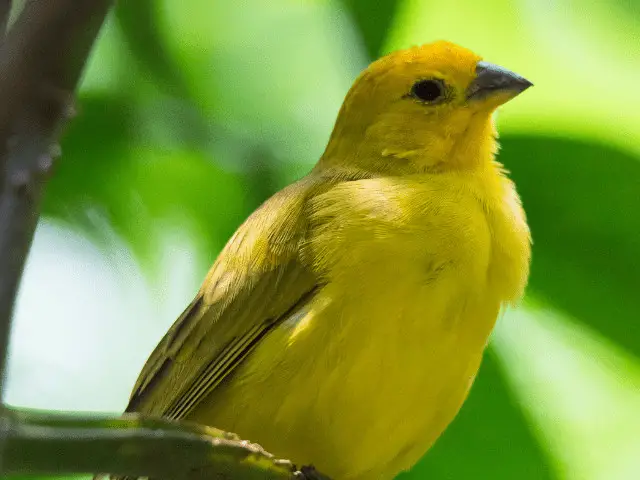Is yellow your favorite color?
If not...
It might just be! There are over 600 bird species in Texas, and our favorite? Those of striking yellow plumage!
These birds will bring you brightness and positivity as you go for bird sightings throughout the state.
Allow us to walk you through ten of Texas’ yellow backyard birds and what they’re all about. Below we'll talk about everything, from their appearances to what food they love.
Fourteen Of Texas’ Yellow Birds (With Photos!)
1. Great Crested Flycatcher
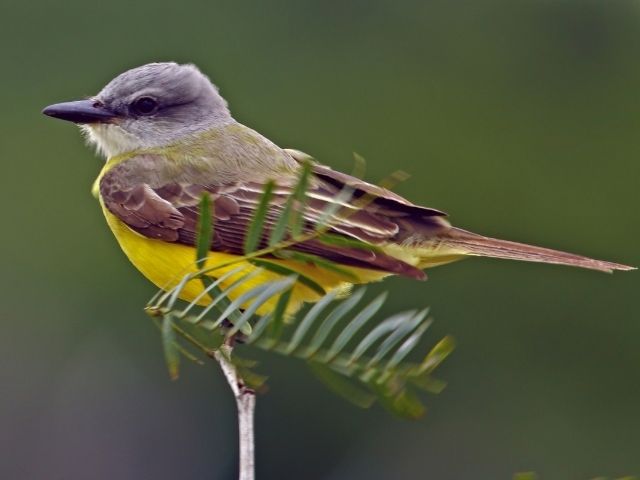
The Great Crested Flycatcher is known for its long tails, big heads and bills, and bright yellow bellies. What makes it better is that their gray tone greatly contrasts their yellow bellies, making them stand out even more.
They’re pretty much an ombre of lemon yellow and gray all over, except for their tail and wings, which are cinnamon brown.
They commonly spend their time perching on woodlands waiting to catch large insects with their wings and devour them. They’re also greatly interested in berries and places with native plants.
2. Orange Crowned Warbler
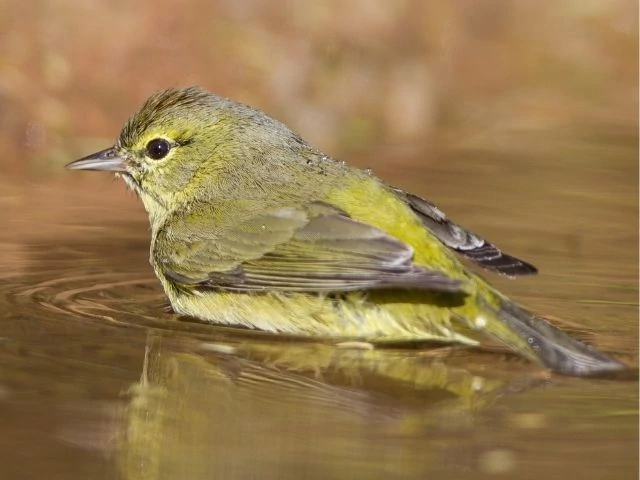
They can be spotted in the state during winter, starting from September to mid-February; sometimes, they can be spotted in other seasons when they’re migrating.
They love hanging out in shrubs, open woodlands, and low vegetations.
These Warblers love insects; their diet consists mainly of their favorite spiders, caterpillars, and flies. They also snack on fruits, berries, and seeds, so make sure to set your backyard feeders.
3. Orchard Oriole
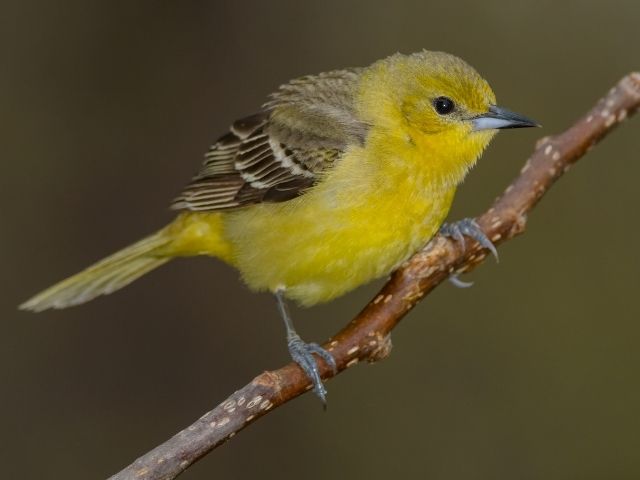
An Orchard Oriole’s dark rustier yellow-orange plumage is definitely something you need to see up close!
They have a black hood, back, wings, and tail, just the perfect contrast for their vibrant tone.
These birds are summer residents as well, so if you ever visit Texas during this season, make sure to go bird watching in the orchards and residential shade trees.
4. White-Eyed Vireo
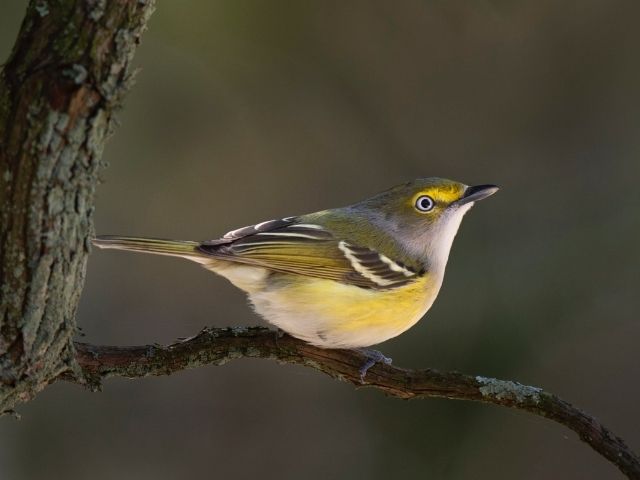
Notice anything different?
Animals with white eyes are very rare, but thankfully, the White-eyed vireo has your back!
They are in Texas all year long and are very easy to spot. They have the habit of staying in thickets and overgrown pastures and brambles because those are the places where their favorite insects, flies, and spiders commonly are.
They are small birds with a contrast of gray and yellow tones all over them. Their white highlights over the throat and underneath their tail provide them with the unique plumage they deserve.
5. American Goldfinch

American Goldfinches are famous for their solid and bright black and yellow combination of plumage, making them easier to spot.
This small bird possesses the bright lemon yellow and pitch-black plumage with strikes of white and grey; female breeds lack the black cap.
An American goldfinch would likely be spotted in the state during winter (September to April); they enjoy areas like open fields, backyards, and clear-cut residential areas.
Plus, they’re less likely to visit areas with dense forests and mountains, so you can pretty much expect them to show up on your bird feeders.
They spend most of their time foraging for sunflowers, thistles, milkweed, and aster plants. If you want to attract them, you can either plant thistles in your backyard or set up a feeder full of sunflower and nyjer seed.
6. Cedar Waxwing
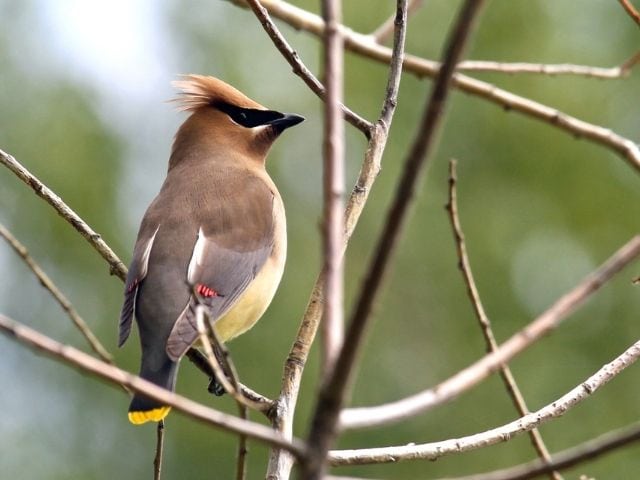
These sleek and smooth-looking birds may appear greatly territorial and aggressive, but they’re the friendliest and sweetest ones ever!
Their yellow bellies and tail tip make fawn-brown feathers look extraordinary and not at all common. They have this black line of a mask over their faces and eyes and a wispy crest.
You can often find them traveling in flocks to places full of insects or fruits.
Any open habitats like juniper woodlands and towns should have at least a few of them because they’re very abundant in Texas.
Cedar Waxwings produce a high-pitched call and a sighing whistle depending on their activity. They commonly make this trilled “bzeeee” sound in flight.
7. Yellow-Rumped Warbler
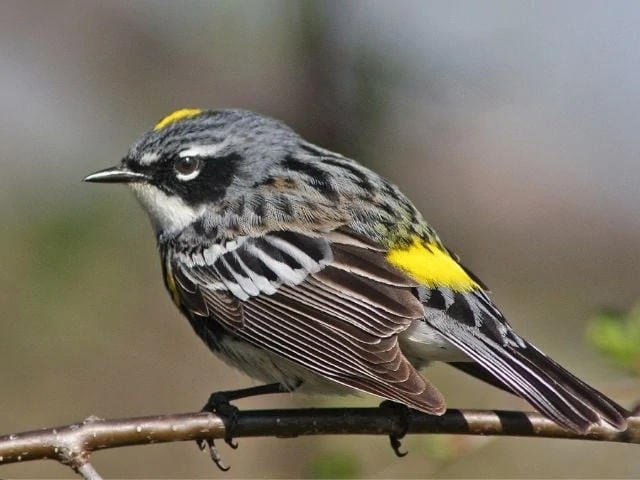
These flashes of yellow over their faces, sides, and rumps go perfectly well with their white wings and black feather tips.
They are spring and fall migrants in Texas but are most commonly spotted during the wintertime (September and October to mid-March).
Coniferous forests, fruiting shrubs, and backyards are the places where you would most likely see them.
If you’re going birding, make sure to visit open areas during winter; and if you’re trying to attract them, start filling your feeders with seeds, raisins, and grab suet with peanut butter.
8. Yellow Breasted Chat
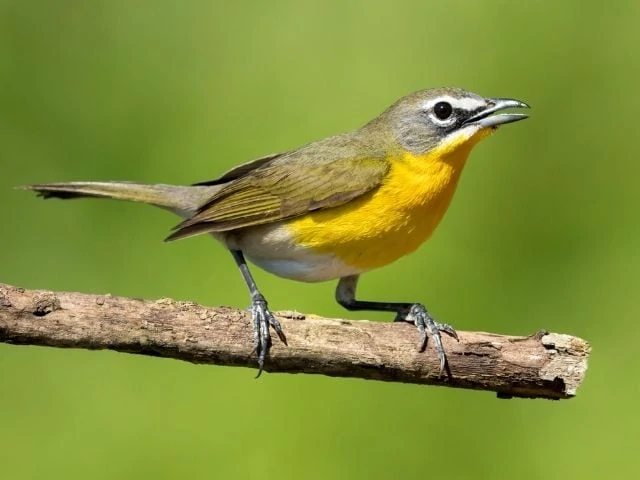
The Yellow Breasted Chats are rare species with the truest mango yellow plumages.
They’ve got olive-green upperparts, wings, and foreheads. Their lower bellies are white, and their faces have a black patch with a single white stripe above the eye.
They are summer residents throughout Texas; they are migratory birds that travel during spring and fall and can commonly be spotted in tangles and wet woods.
These Chats snack on various insects, from ants to beetles, unusual for songbirds.
They also feed on fruits like blackberries, strawberries, and grapes.
9. Lesser Goldfinch
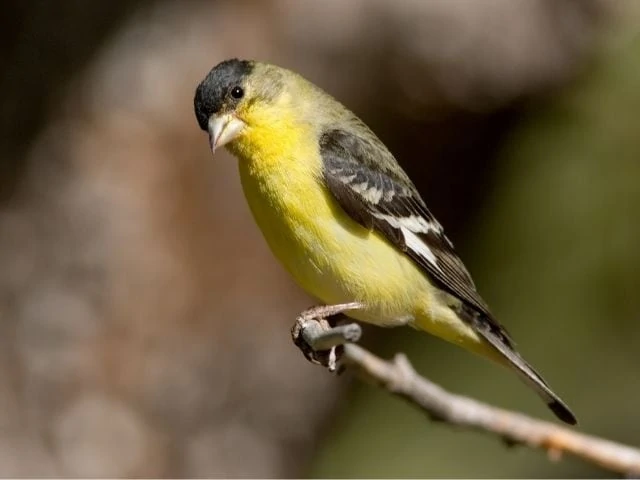
The Lesser Goldfinch show off their uniqueness by maintaining their bright-yellow plumages all year long, even during wintertime when American goldfinches tend to lose their yellow plumage and fade into brown.
Their feathers are bleeding and fading from yellow-brown to gold and light yellow. Their wings have a black and white stripe-like pattern, and they’ve got a little black mask over their eyes.
As summer residents in the Western half of Texas, these songbirds reside near water and arid regions. You can also spot them in residential areas, so don’t hesitate on getting a feeder.
Seeds, fruits, elderberries, buds, and sycamores are a few of the many things they love. Tube feeders and platform feeders work best in attracting a lesser goldfinch too.
10. Yellow Warbler

Yellow Warblers are bright yellow birds with green-yellow upperparts and wings. The makes have chestnut streaks over their breast that allows them to be easily distinguished.
You can see them in Texas during their migration period in spring and fall. Some prefer to remain in the state, while most leave after this period.
Streams, wetlands, thickets, and along the edges of fields, they forage for insects like caterpillars, beetles, and wasps.
These birds are shy and eat insects almost exclusively, but if you fill your backyard with plants and trees surrounding it, then there shouldn’t be any hassle.
11. Common Yellowthroat
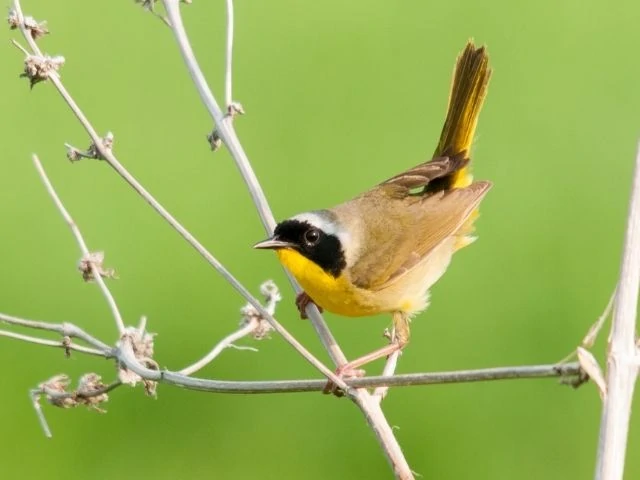
Common Yellowthroats get their name from their iconic vivid yellow plumage that spreads from underneath their tail way up to the bottom of their beaks.
They’ve got brownish upperparts, and their faces have a very distinctive black and white single stripe mask.
They live up to their name (“common”) by being around the state of Texas all year long. These are migratory birds, they travel and breed over the spring and summer to increase in numbers.
They prefer to stay in marshy/ wetland areas and bushy fields. Thick and tangled vegetations are where they feel most comfortable and safe in. And because of this, they only eat insects.
12. Orchard Oriole (Female)
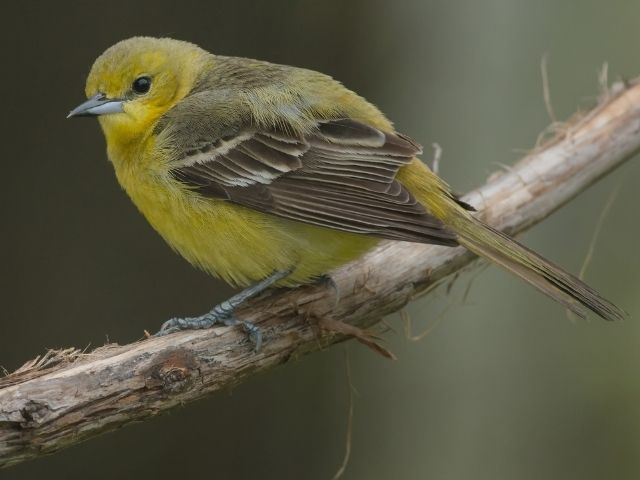
Female Orchard Orioles have a yellow-based plumage topped with brownish-grey wings and a dark mask over their faces. On the other hand, Males have a reddish base instead of a mango yellow.
They are more frequently seen during summer in between the months of April and October. They breed and increase in numbers during spring and fall when migrating; you may spot them during these periods too, but rarely.
These little birds prefer open woodlands, riverbanks, farms, and even backyards. They primarily snack on insects like ants, caterpillars, and spiders, but they also have the habit of drinking nectar from flowers and eating fruits.
13. Magnolia/ Pine Warbler
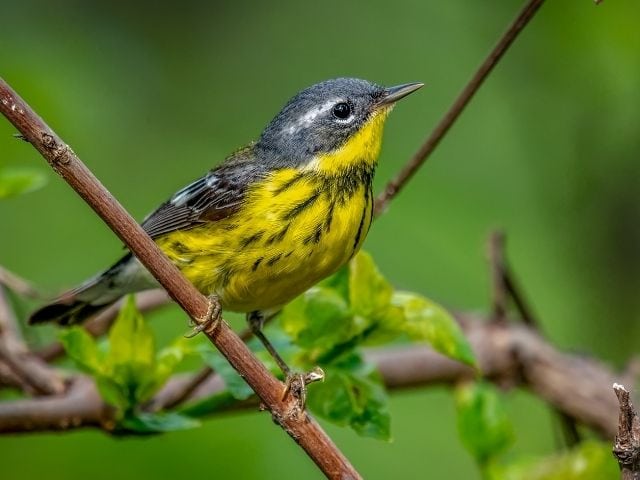
With a grey and yellow plumage combination, you may think that they’re much harder to spot compared to other warblers. However, these birds stay on low branches, so you won’t have any trouble seeing them.
They have a very distinct necklace-like streak color of black on their necks down to their bellies. Females are more on the greyish side, while males tend to have a darker black tone.
A Pine Warbler is commonly spotted during the spring and fall seasons of the state on forests, thickets, and plantations.
Their diet almost exclusively consists of the insects they forage for on lower and middle branches of trees.
14. Couch’s Kingbird
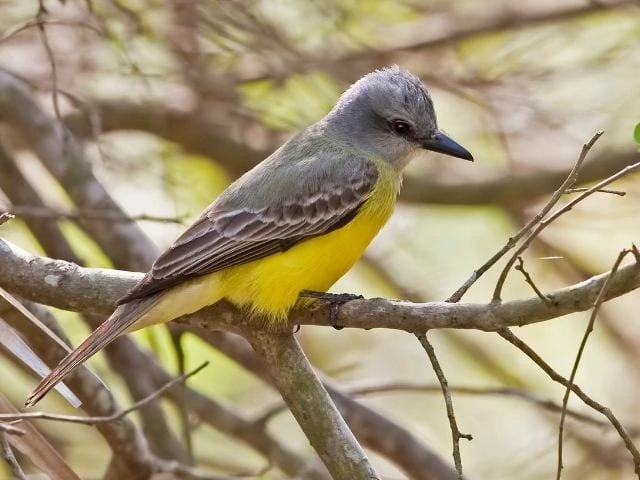
Couch’s Kingbirds are a lovely species that is very easy to identify!
Their plumage is very basic, with grayish-brown wings, bright yellow breasts, and underbellies. They’ve got a whitish throat and a black bill and tail.
Backyards are also one of their favorite places to visit; if you’ve got a stocked feeder and some trees around, you can expect them to show up.
They eat insects and fruits; you can fill your feeders with mealworms and dried insects or assorted dry fruits.
Fun Fact: Birds love to take a bath most especially in fountains! Why not try out the "3 best bird bath heaters" to see what works for them or not?
Frequently Asked Questions
What does it mean when you see yellow birds?
Birds with striking yellow plumages are spiritual messengers of primal instincts and personal power. At times we may feel down and defeated, but if you happen to catch sight of a yellow bird, it might be a reminder that you are stronger than you think you are. Act positively and get back on your feet; you can do it!
What kind of Texas bird has a yellow belly?
Western Kingbirds are known for their conspicuous tail during a flight and their appealing yellow belly. These birds’ plumage makes their yellow bellies look caped over by their gray wings.
Listen to their amazing sound in this video:
What is the difference between a yellow finch and a goldfinch?
None at all because they’re the same bird! A yellow finch or more commonly known as a goldfinch is a year-round bird commonly found in Texas. Although it is commonly compared to a yellow warbler, it's not different from a yellow finch.
What kind of bird has yellow and gray plumage?
Have you seen a beautiful bird with tones of bright yellow and soft grey? That might just be the Western Kingbird. They’re large birds with exceptional insect-catching skills; their plumages make it easier for birders to set them apart from other species.
Is it legal to hunt migratory birds?
According to the Migratory Bird Treaty Act of 1918, it is illegal in any state (not just Texas) to hunt, take, capture, kill, and even sell migratory birds that fall into the 1,100 species listed by the government.
The Migratory Bird Treaty Act is what allows these birds to exist freely and thrive without having the risk of going extinct or being highly domesticated.
Wrapping Everything Up
Have you chosen your favorite yellow bird yet?
Now that you know all about them, it’s time to schedule your travel to the state of Texas and see them up close. Don’t forget all of your bird-watching materials, protective equipment, and this article as a guide!
But if you're not a fan of going out just for bird sightings, you can always let these beautiful birds come to you instead. Attract these backyard birds using the information about their diet above.

